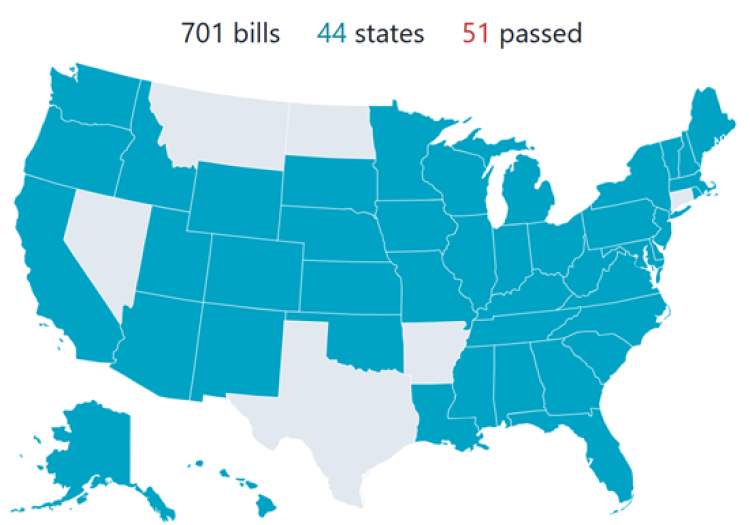Patterns of Language Use in Anti-Trans Legislation by Caitlin Amero

What linguistic and rhetorical strategies do lawmakers use to promote anti-trans legislation?
By: Caitlin Amero
Course Title: LING 2400, Language, Gender, and Sexuality
Instructors: Maureen Kosse and Emma Bornheimer
Nominator: Emma Bornheimer
In 2024, 88 pieces of legislation were considered by the United States Congress that sought to restrict various privileges afforded to transgender individuals across the country. Identified and compiled by the Trans Legislation Tracker, an independent research organization, these federal anti-trans bills emerged at a higher volume than in any previous year. Through qualitative coding, I analyzed 30 such pieces of proposed legislation in order to uncover the linguistic and rhetorical strategies most frequently used in the creation of anti-trans bills at the federal level. My analysis yielded four broad categories of linguistic and rhetorical patterns recurring across the bills I evaluated:
| Strategy Category | Strategy | Prevalence |
| Obscuring Strategies | Phrases of Universal Appeal | 18 - 60% |
| Floating Signifiers | 12 - 40% | |
| Acronymic Titling | 7 - 23% | |
| Protection Rhetoric | Children’s Salvation | 11 - 37% |
| Parents’ Rights | 8 - 27% | |
| Women’s Rights | 4 - 13% | |
| Constructed Hostility | Antithesis Framing | 12 - 40% |
| Exaggeration of Threat | 6 - 20% | |
| Inverted Activism/Fascism | 6 - 20% | |
| Denial of Ambiguity | Defining Sex | 23 - 77% |
| Minimization of Subjectivity | 13 - 43% | |
| Intersex Exemption | 11 - 37% | |
| Naturalization of Language | 6 - 20% |
Obscuring strategies seek to disguise the true intent of a legislative measure, such as through “phrases of universal appeal.” These are statements that nearly everyone would be sure to agree with, such as in the title of the “Stopping the Mutilation of Children Act.” Through phrases of universal appeal, controversial bills purport to be about something more agreeable and thereby avoid seeming directly trans-antagonistic. Some titles also use acronymic titling conventions to obscure bill topics. Floating signifiers like “radical” also contribute to obscurity because they are not “meant to inform; rather they serve as buzz-words” inciting agreement without understanding (Weirich, 2023).
Anti-trans bills often assert the purpose of saving and protecting the rights of some group of people, rather than being open about the fact that they intend to take away the rights of another group. This is protection rhetoric. The three groups most commonly used as targets of salvation by the proponents of these bills are women, parents, and with the most frequency, children. Protection rhetoric is an example of virtue signaling, through which politicians capitalize on the fear that their own dog-whistling incites by portraying themselves as saviors ready to tackle purported threats. In this way, protection rhetoric is a linguistic tool through which conservative legislators perform their identities as “virtuous … gender binary traditionalists” who are unafraid to take a stand to protect women, children, and family values (Cannon, 2022, p.161).
Anti-trans legislators, then, become heroes fighting against transness, framed as dangerous via the construction of hostility. One strategy within this category is antithesis framing, which promotes the idea that the acceptance of transness in society would be mutually exclusive with and antithetical to Americanness, tradition, and moral or religious values. This strategy is similar to the rhetoric of inverted activism and fascism, which utilizes the linguistic process of grafting, in which proponents of a conservative ideology use “well-established rights vocabulary” to reverse the “discursive and semiotic fields,” positioning themselves as oppressed and marginalized, advocating for their rights (Borba, 2022, p.59-60, 73). By framing themselves in this way, the authors of these bills construct trans people and trans rights activists as hostile oppressors, utilizing the “linguistic … legitimation” strategy of “inverted fascism” (Tebaldi, 2023, p.20-21). The exaggeration of threat is another pattern that constructs hostility by suggesting that trans rights activists intentionally cause harm, or that the acceptance of progressive gender policies would have extreme consequences.
By far the most common theme across the data set is the strict definition of sex, as well as related terms like male and female. This effort relies on a false sense of the stability of language and the assumption that it is possible to identify “direct and universal” meanings (Tao, 2024, p.4) when, in reality, “the meanings of variables are not precise or fixed but rather constitute a field of potential meanings” (Tao, 2024, p.5). Also common is a denial of ambiguity manifesting in the erasure and exemption of intersex individuals from prohibitions on transition-related procedures. Anti-trans legislators identify their authoritative understanding of sex as superior to the minimized subjective experiences intersex or trans people have of their gender. They also claim authority over what terminology people can use to describe themselves and assert that there is an inherent link between language (ex: pronouns) and biological sex through the naturalization of language, by which bills contradict the basic linguistic assumption of the arbitrariness of signs.
Through these main strategies, anti-trans legislators are producing an ever-increasing volume of proposed legislation targeting transgender Americans. Although the majority of anti-trans bills are not passed or enacted, and thus cannot legislatively do anything, they all still do something in the sense of being performative speech acts which index the values of the legislators who write them.
Works Cited:
(2024). 2024 anti-trans bills tracker. Trans Legislation Tracker. translegislation.com
Borba, R. (2022). Enregistering ‘gender ideology’: The emergence and circulation of a transnational anti-gender language. Journal of Language and Sexuality, 11(1), 57-59.
Cannon, L. (2022). The Politicization of Trans Identity: An Analysis of Backlash, Scapegoating, and Dog-Whistling from Obergefell to Bostock. Lexington Books.
Tao, K. (2024). Legal Categorization of “Transgender”: An Analysis of Statutory Interpretation of “Sex,” “Man,” and “Woman” in Transgender Jurisprudence. Cambridge University Press.
Tebaldi, C. (2023). Tradwives and truth warriors: Gender and Nationalism in US white nationalist women’s blogs. Gender and Language, 17(1), 14-38.
Weirich, K. (2023). Indeterminate Fear: Moral Panics and Floating Signifiers. The Prindle Post. prindleinstitute.org/2023/08/indeterminate-fear-moral-panics-and-floating-signifiers.
Caitlin Amero is a junior studying linguistics and creative writing at CU Boulder. Outside of school, she enjoys poetry, crosswords, and improv comedy.



